The Thrill of Backcountry Camping in Algonquin Park
In today's fast-paced, technology-driven society, we are bombarded with notifications, emails and endless to-do lists. It can be easy to forget there is a world outside our screens — a world that moves at a slower pace, where the only sounds are rustling leaves and the serene song of a loon reclaiming the lake.
Algonquin Park’s backcountry is an expansive haven of tranquility. It’s our favourite hiding place, a place we can retreat. This safe space is a need, a fuel — not a necessity. Algonquin is an integral part of restoring and rejuvenating our creativity, and has been since we were young.
The Symphony of Nature
Backcountry camping (also known as ‘interior’ camping) strips life down to its most basic. The challenges we face and overcome in the wilderness provide a fresh perspective, helping us appreciate creature comforts we often take for granted.
A clear night in the backcountry presents a celestial spectacle that's increasingly rare in our light-polluted cities. A canopy of twinkling stars, the ethereal glow of the Milky Way and the occasional streak of a shooting star offer a humbling reminder of our place in the universe.
Above all, the quiet moments spent observing wildlife, untouched and unbothered by human interference, allow us to form a deeper connection with our surroundings. These are the moments we live for. Our reason for waking.
These encounters foster a sense of respect and admiration for all forest inhabitants and their landscapes. The haunting call of a wolf over an illuminated lake and the sight of a moose grazing in the early morning mist have become treasured experiences, etched into memory. Forever encapsulated in our hearts and sometimes, if we’re lucky, on our cameras.
Thriving in the Wilderness
We were eager to be paddling home this June after a long, cold Spring.
Unlike previous years, we set our clocks for 2:30 a.m., strapped the canoe on the roof and took long, winding dirt roads to our put-in spot.
Being kissed by thousands of mosquitos, black flies and deer flies is always worth it when put into perspective. Algonquin’s backcountry holds a special magnificence, the unknown of what could grace our path feels similar to the wonder of Christmas Eve. Sometimes, it’s pure magic.
This season, we had enough time between photography workshops to get away for two nights. And, I must admit, for a short trip…it was record-breaking for us. We had 34 different moose sightings in 48 hours, six of which were moose calves.
For this adventure, we rented the Canon EF 400mm f/2.8L IS III USM (because the lighter RF version was spoken for) and the Canon EF 200-400mm f/4L is USM Extender 1.4x (because we were curious). Sidebar: To say our wrists and forearms were sore by our last day backcountry is a grave understatement!
The most memorable moment was witnessing a VERY pregnant cow moose grazing while a majestic bull stood watch. We were surprised to see a cow moose pregnant so late in the season, but she didn’t appear to be having complications — she danced across calm waters for over an hour, eating all the lilypad bulbs, escaping the ramped black flies and soaking in the sun.
This particular bull moose was impressive, with an already full rack and healthy stature. He greeted us both days of our trip. The first, he was curiously observing the cow moose swim with a mouthful of greens. The next, we discovered him napping atop a dense patch of peatlands before he too decided to take a dip and float past our canoe. Neither were shy, and certainly weren’t bothered by our presence.
View some of our favourite captures from this trip in the slideshow below.
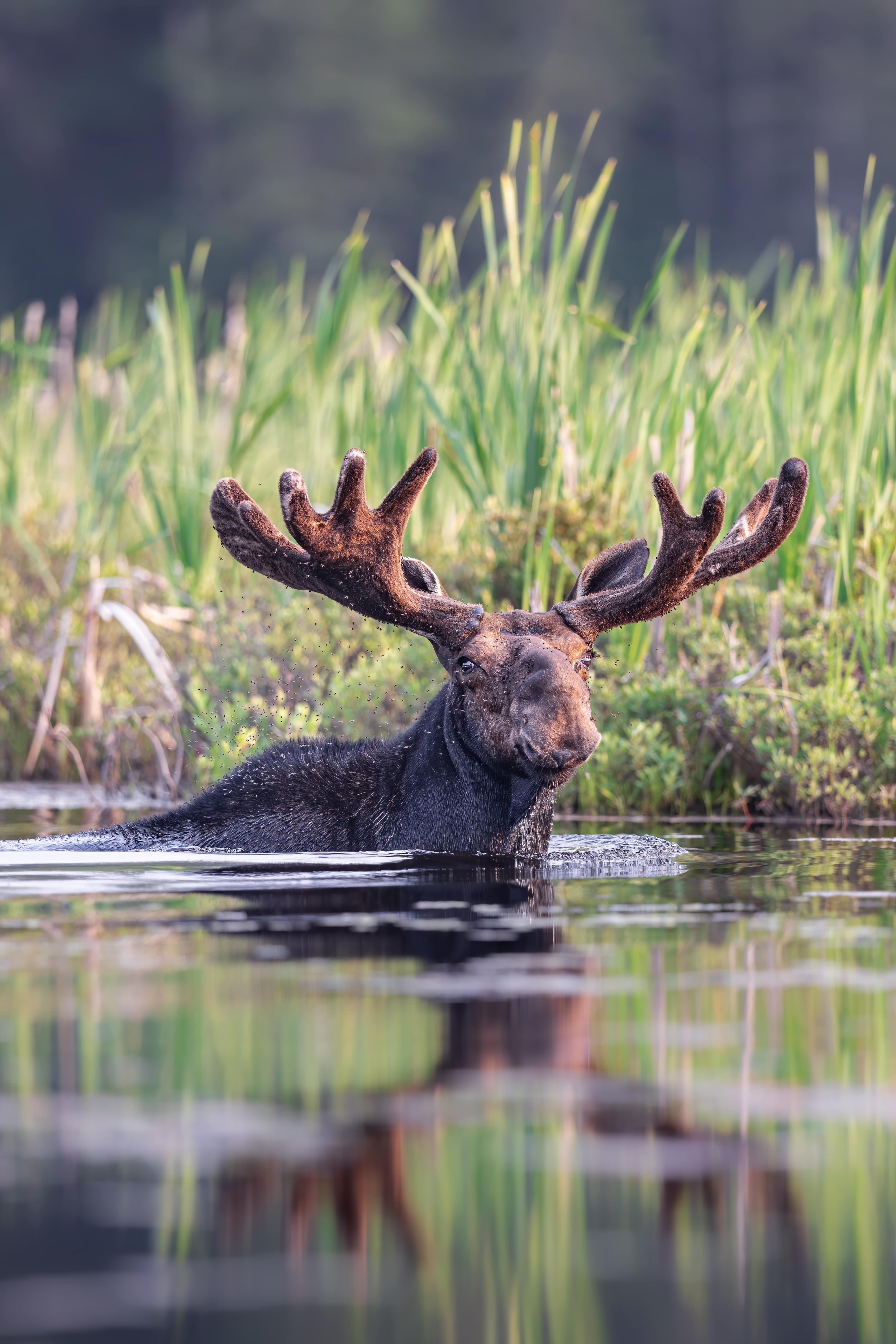
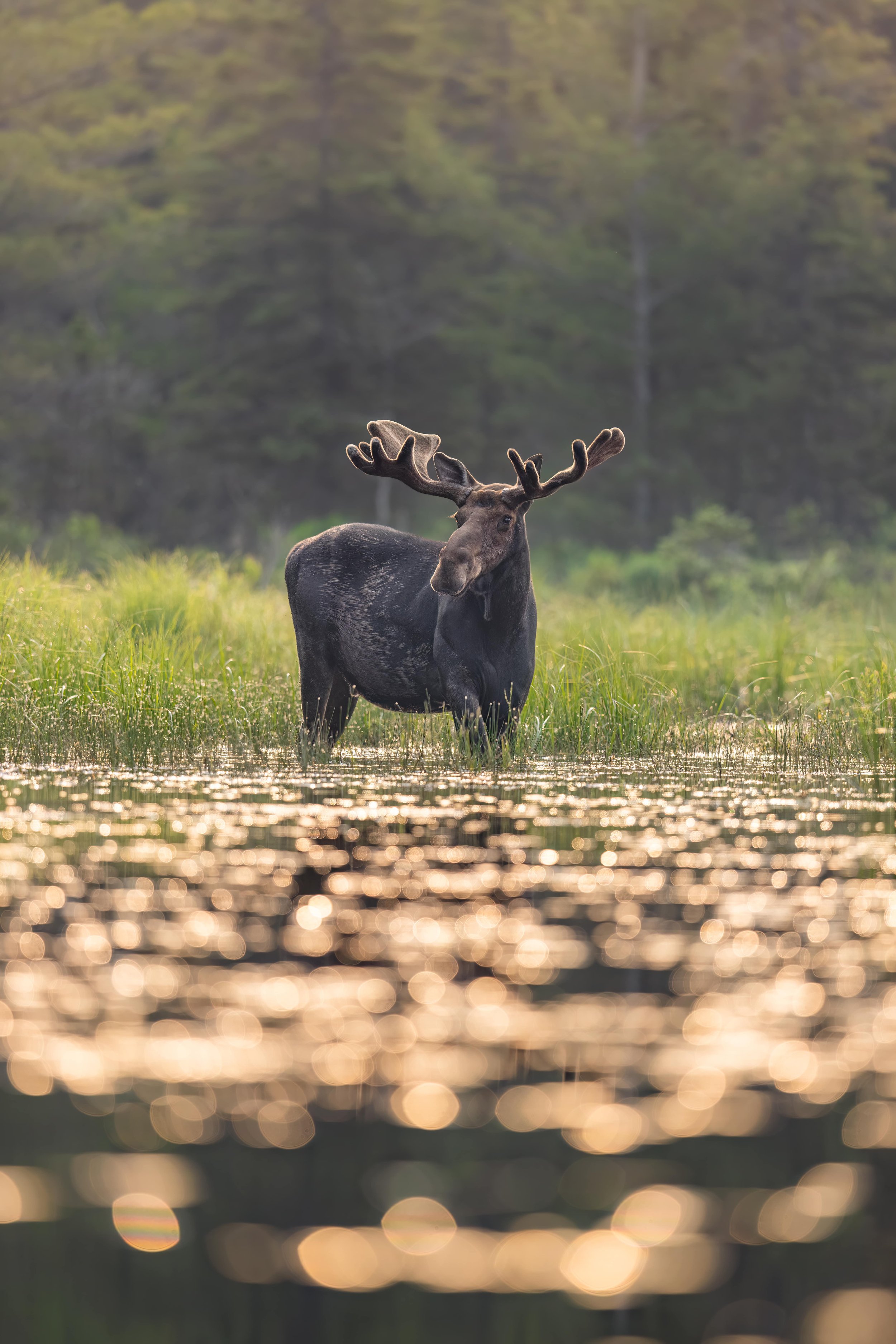
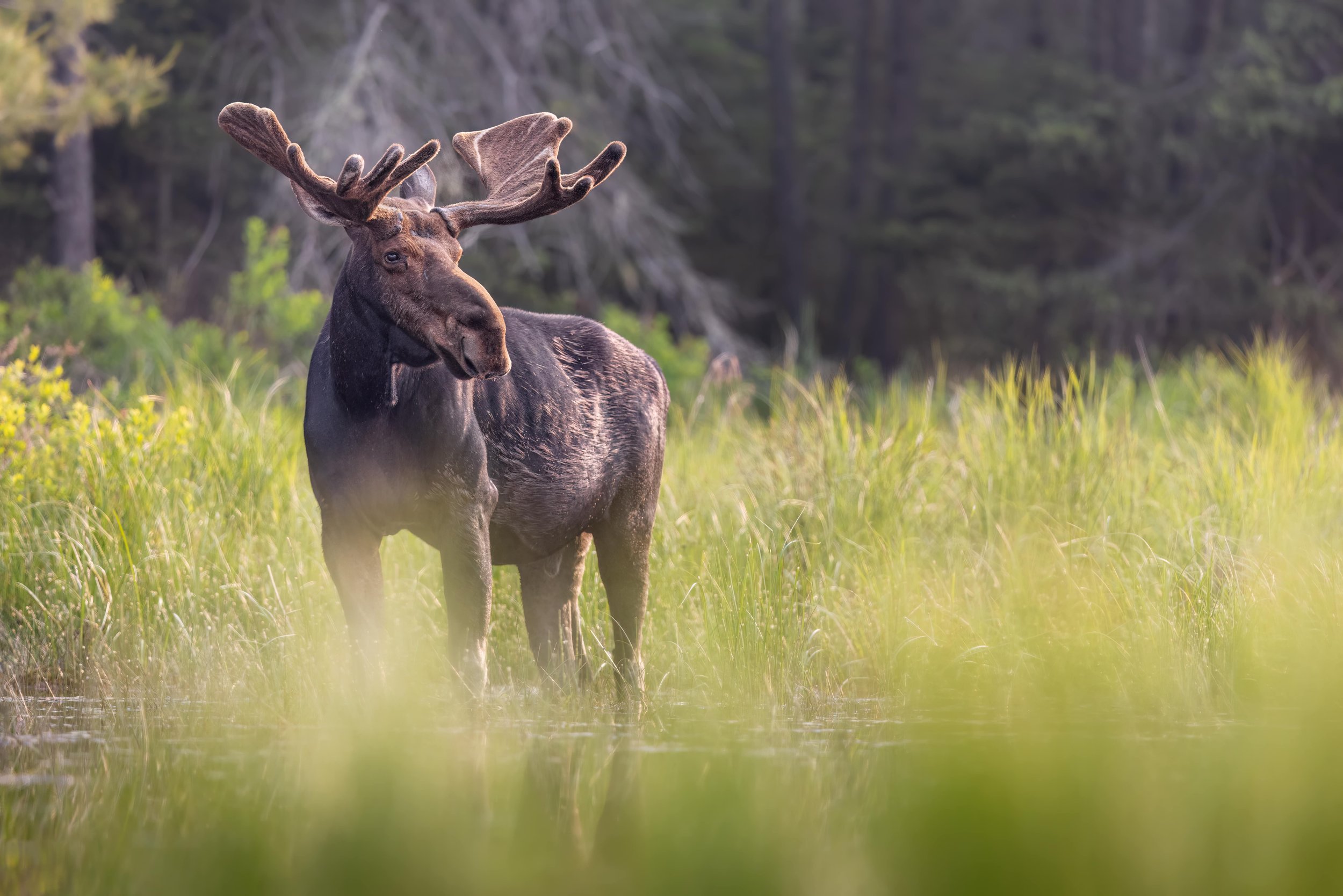
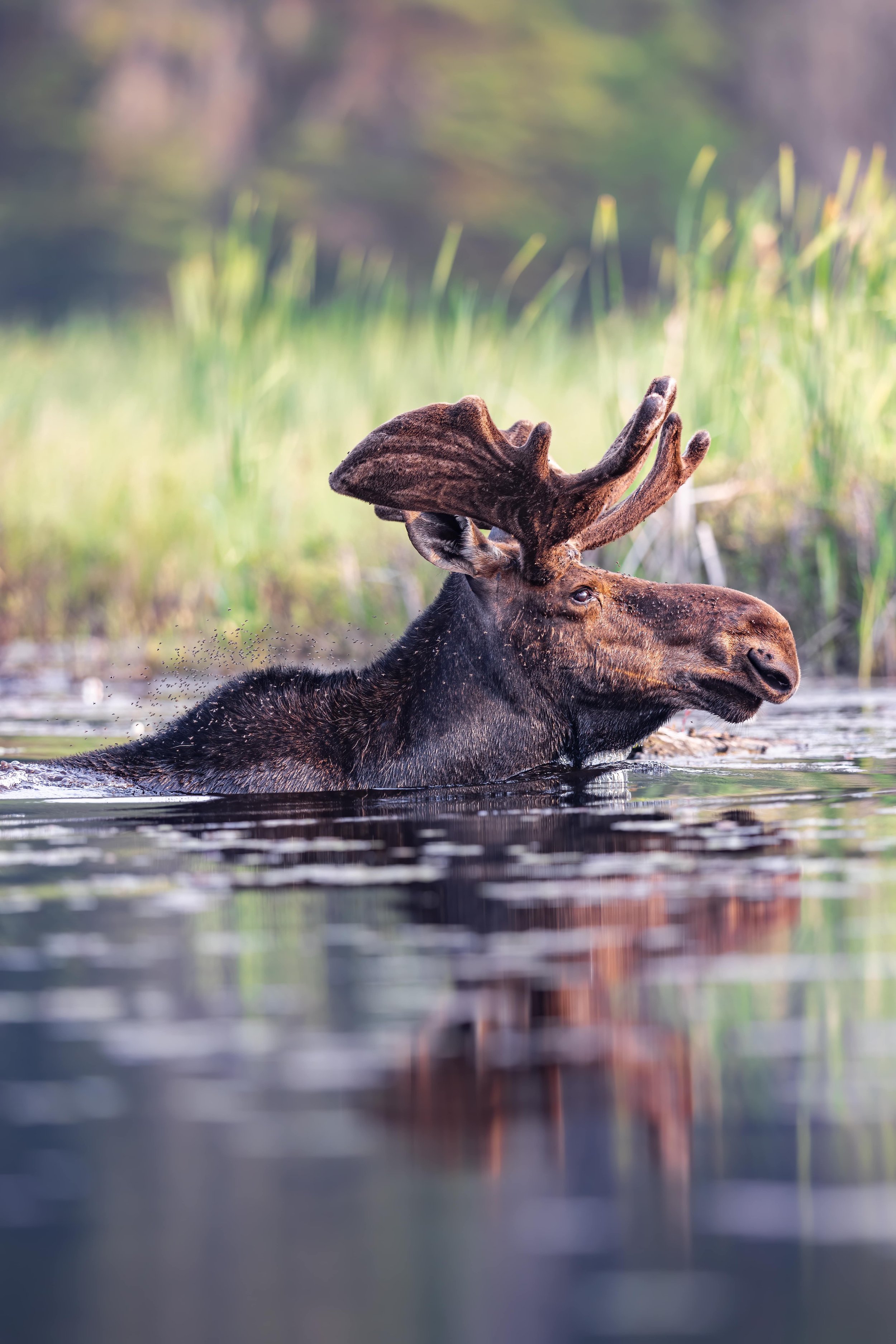
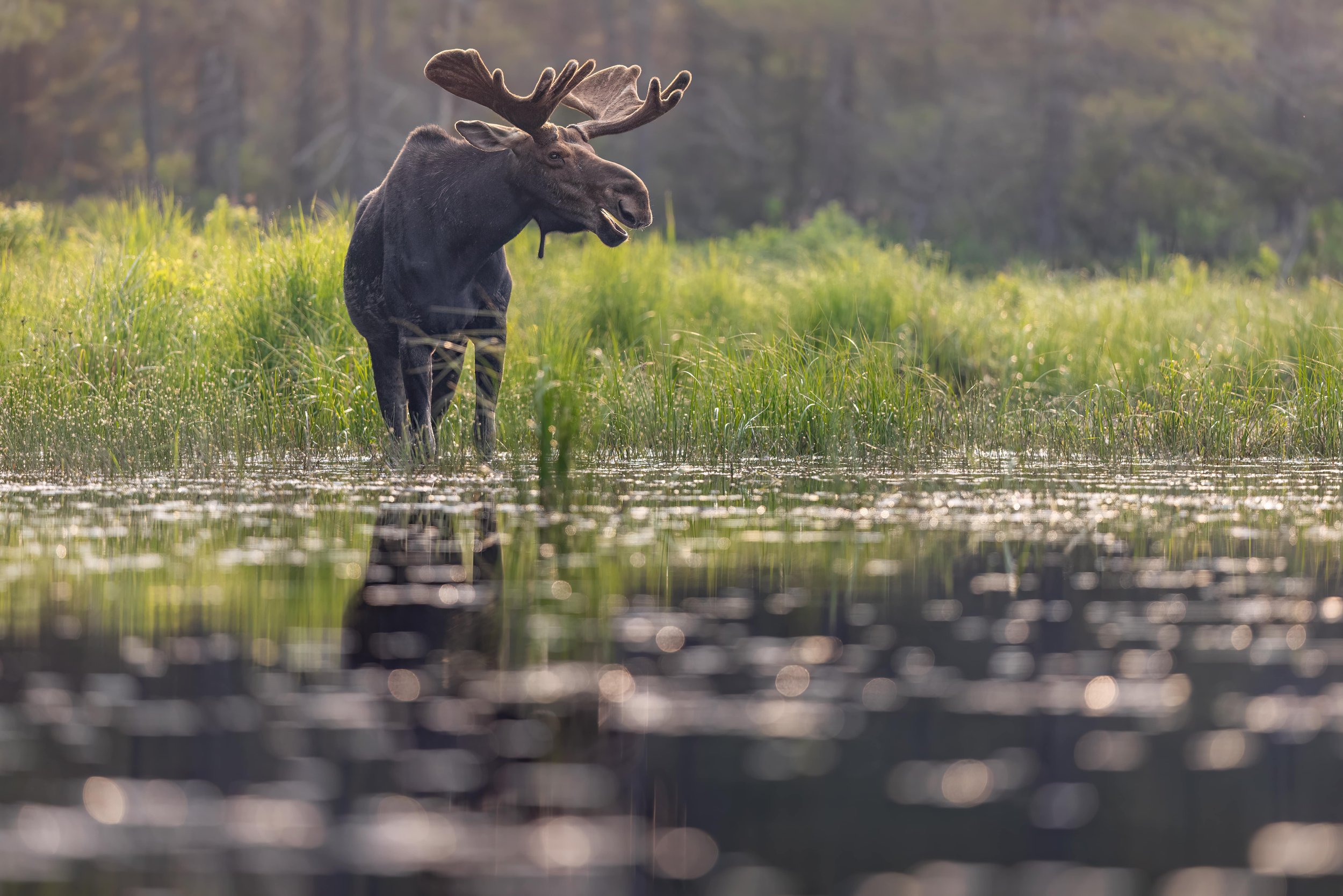
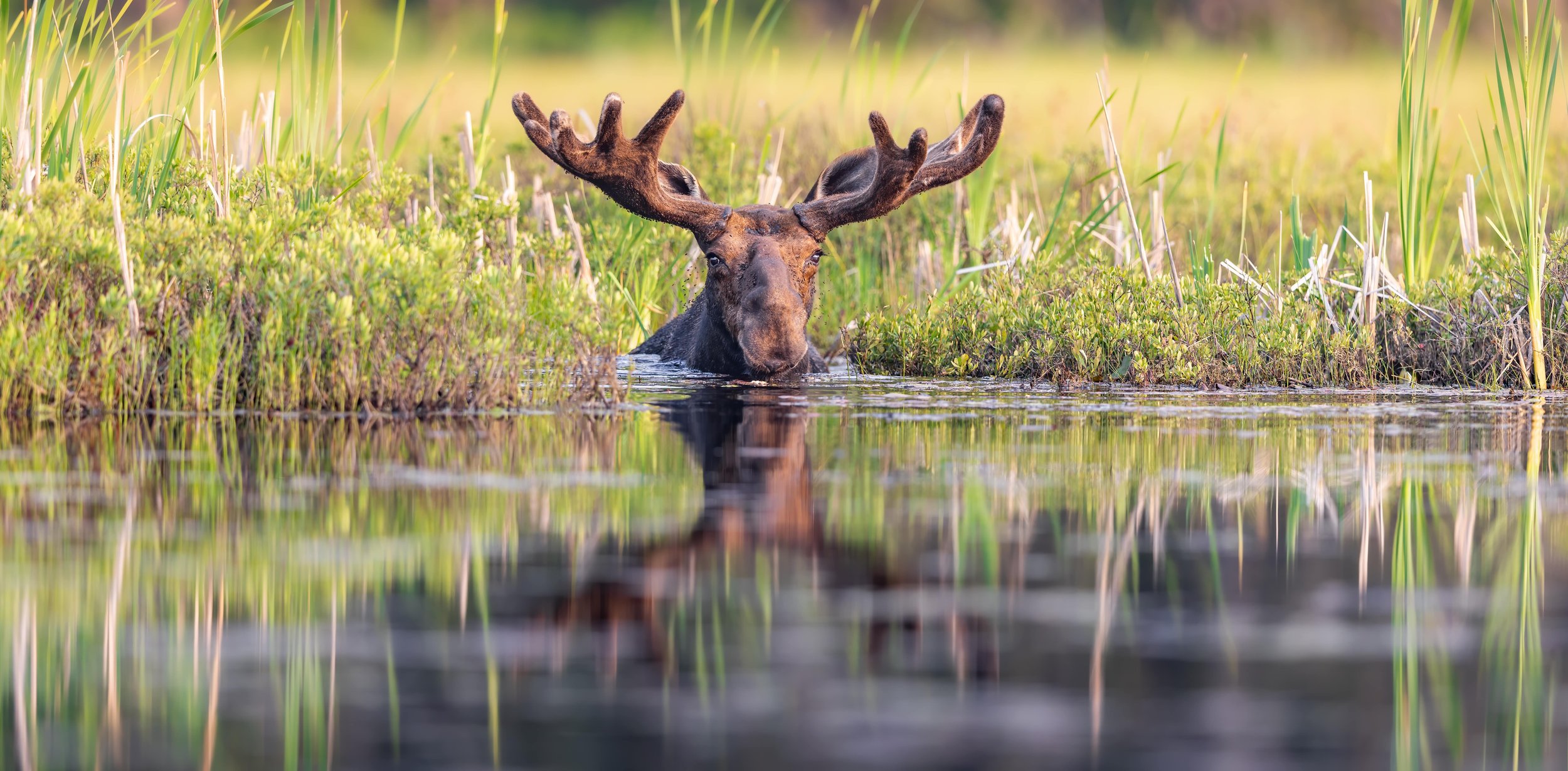
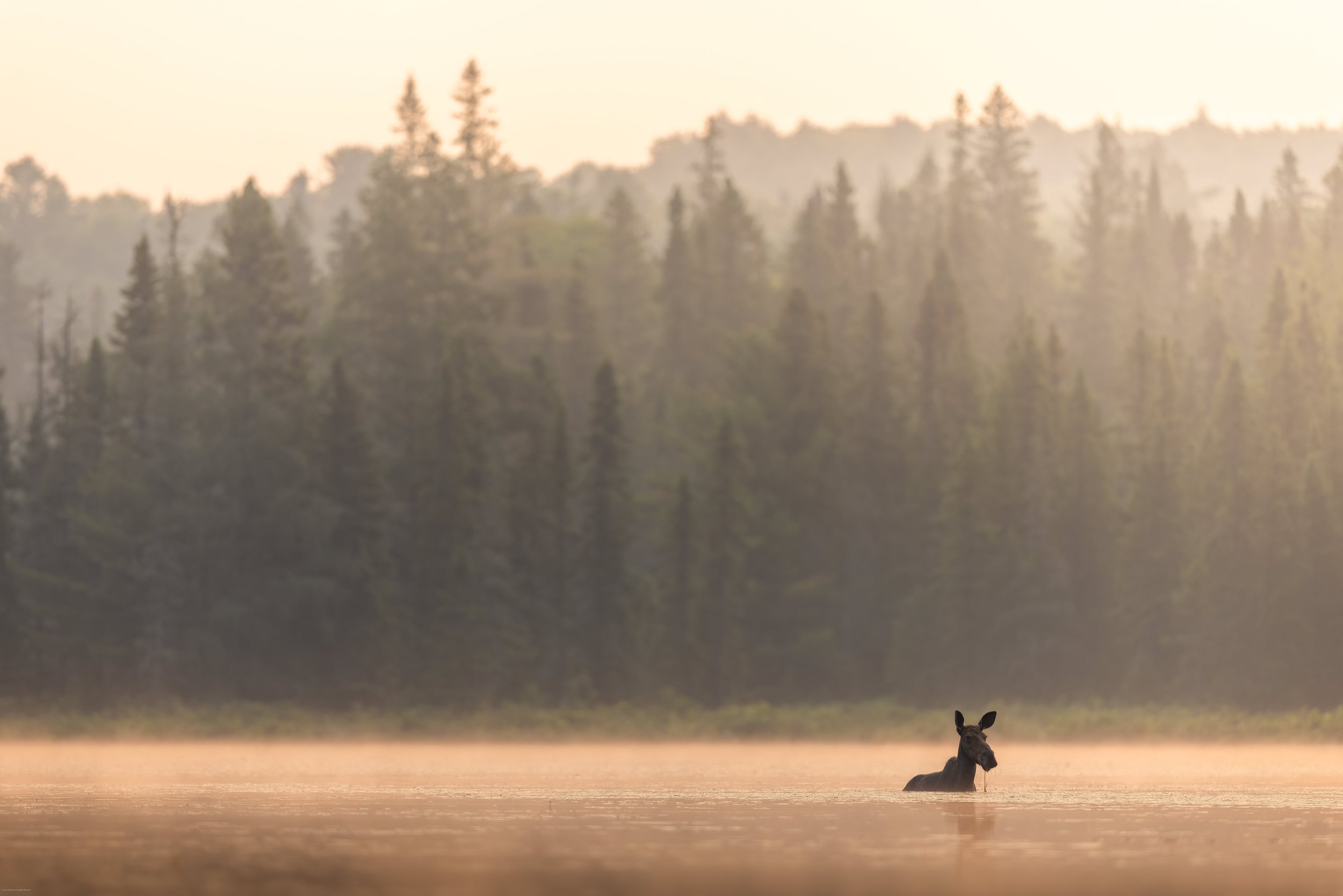
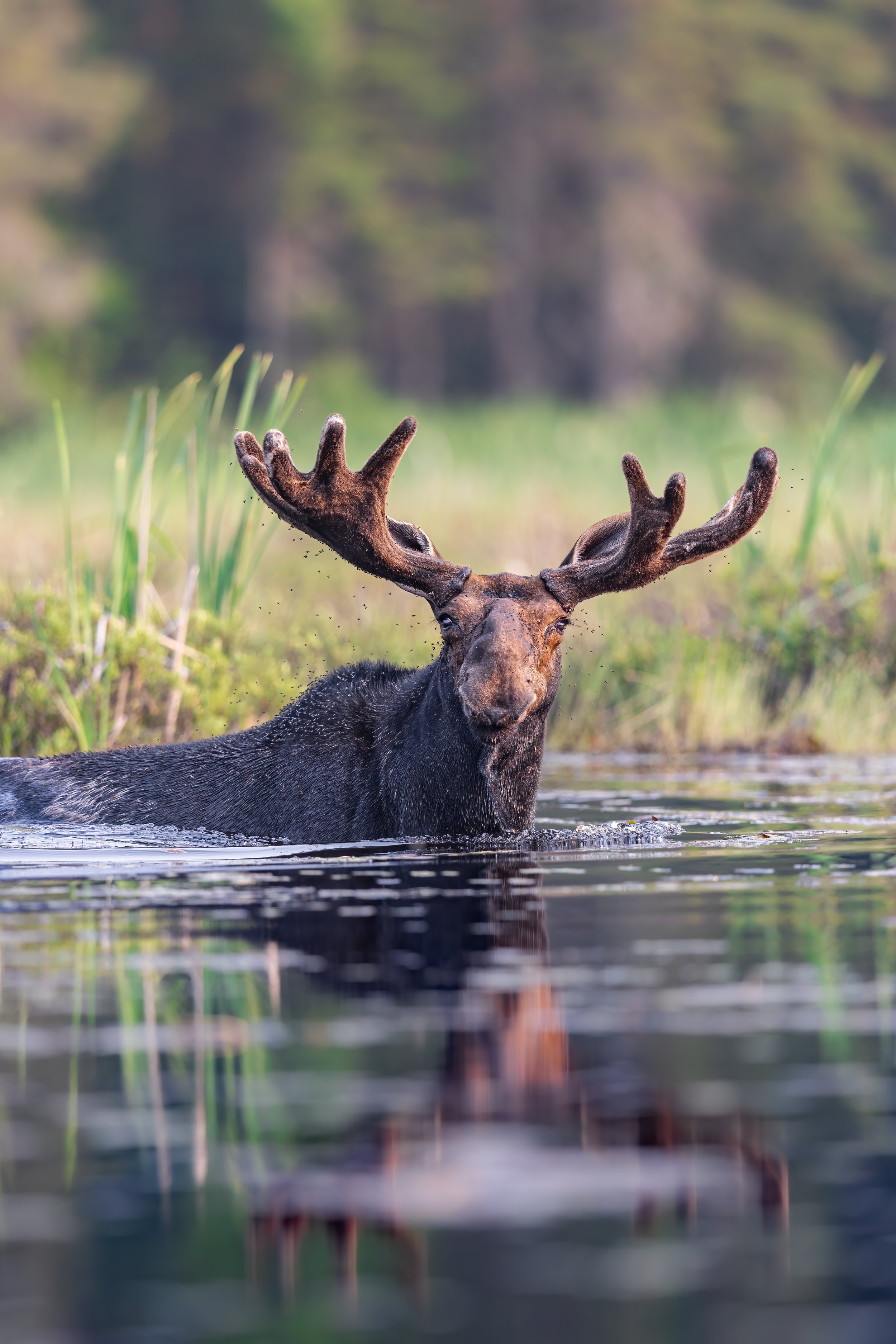
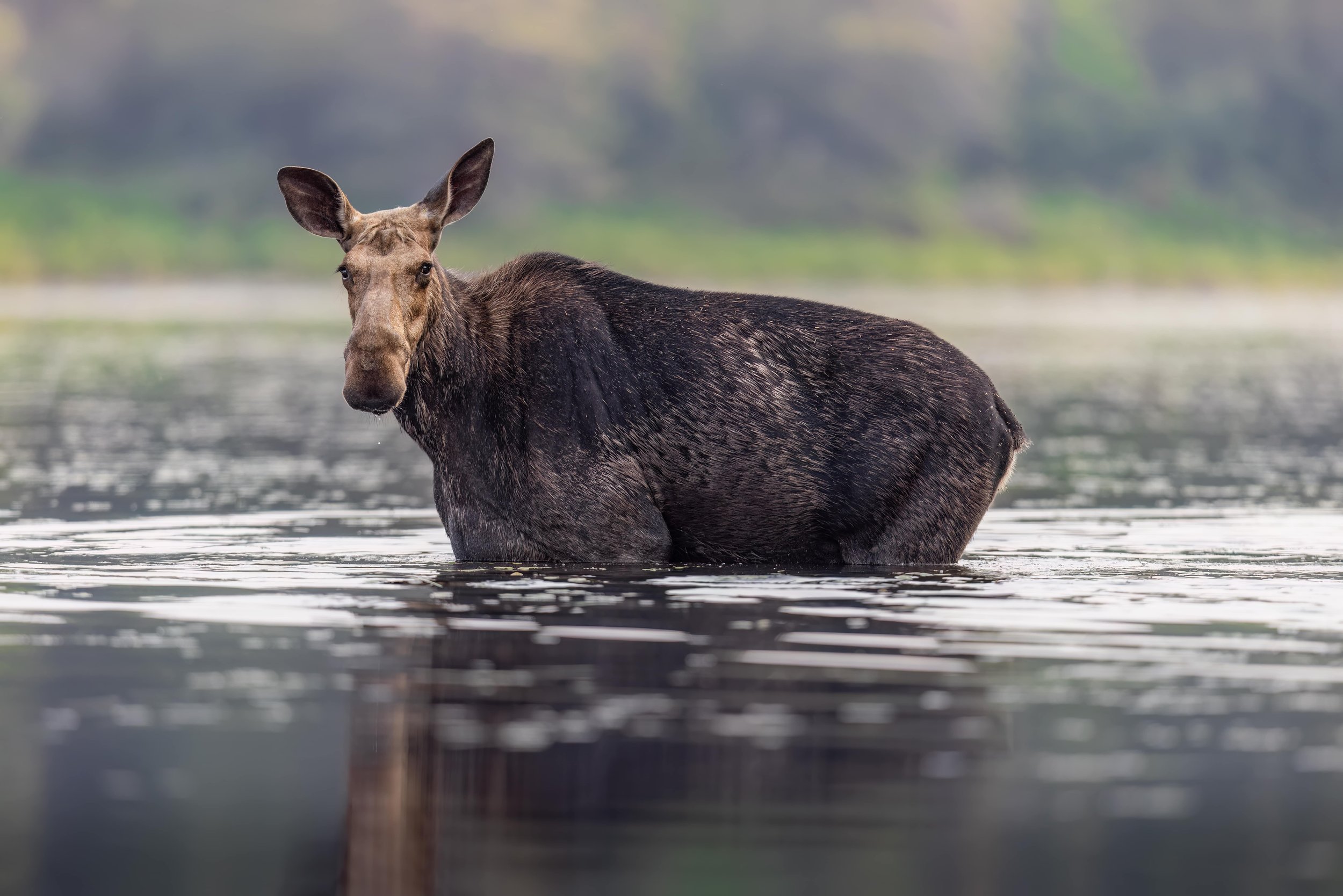
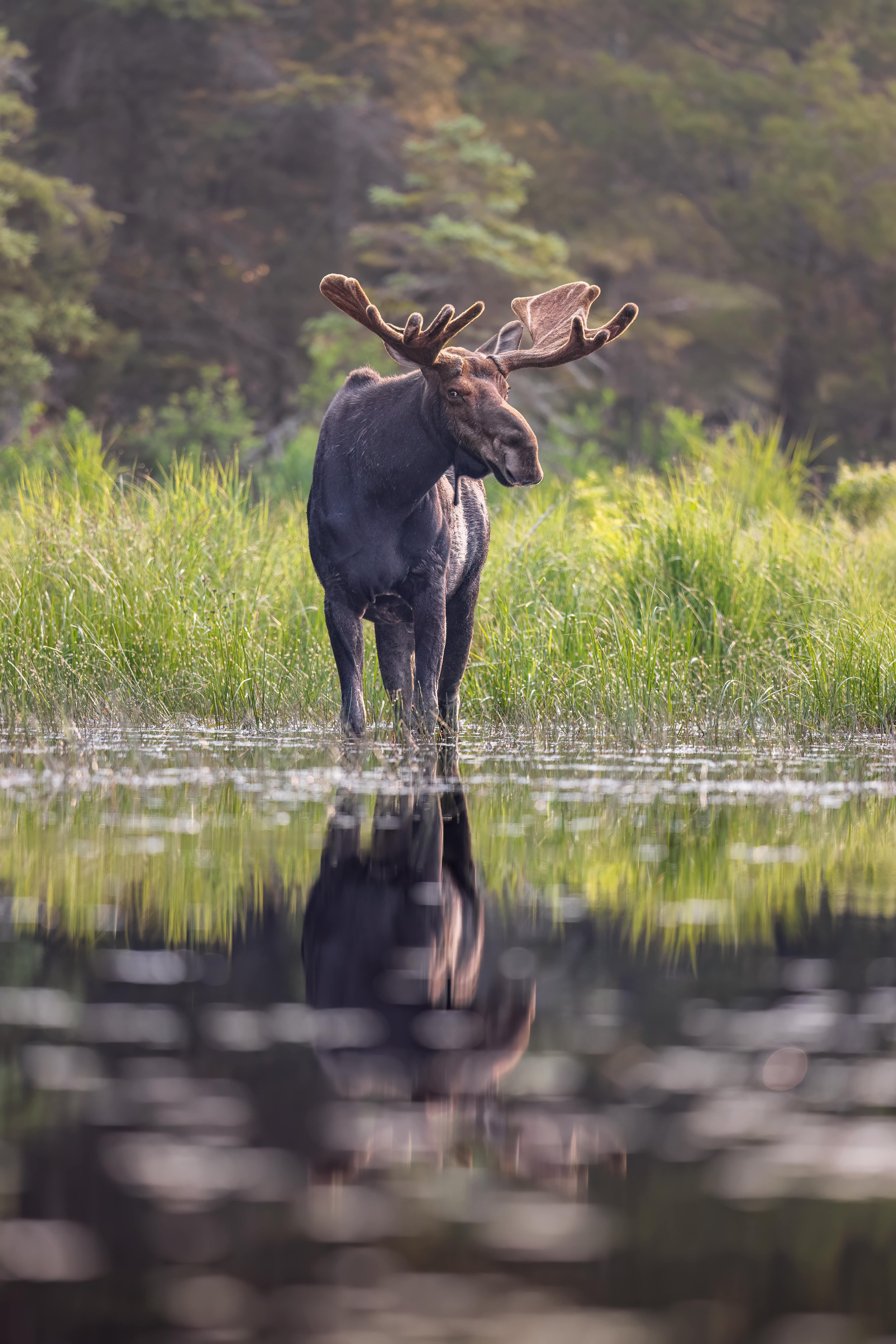

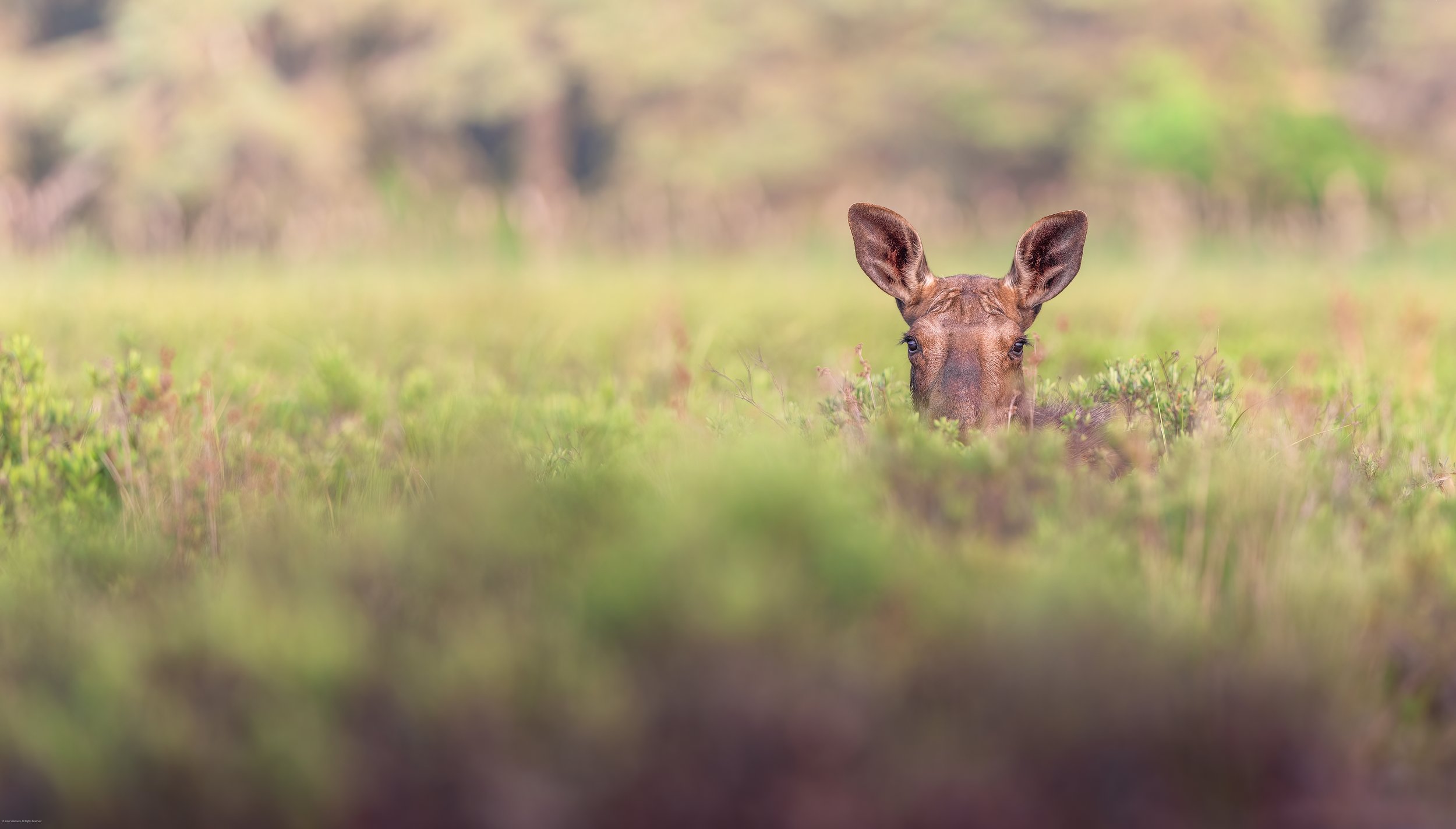
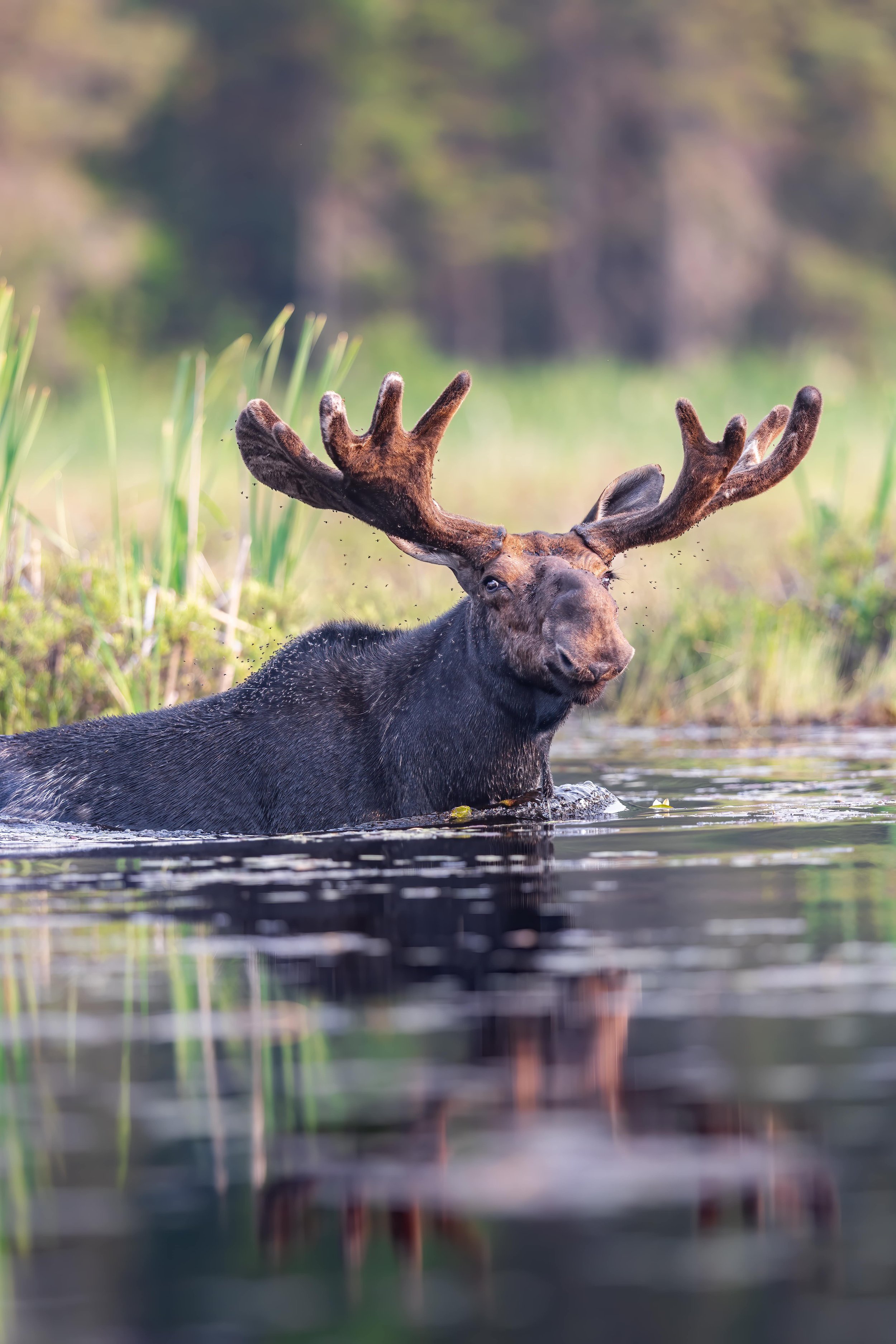
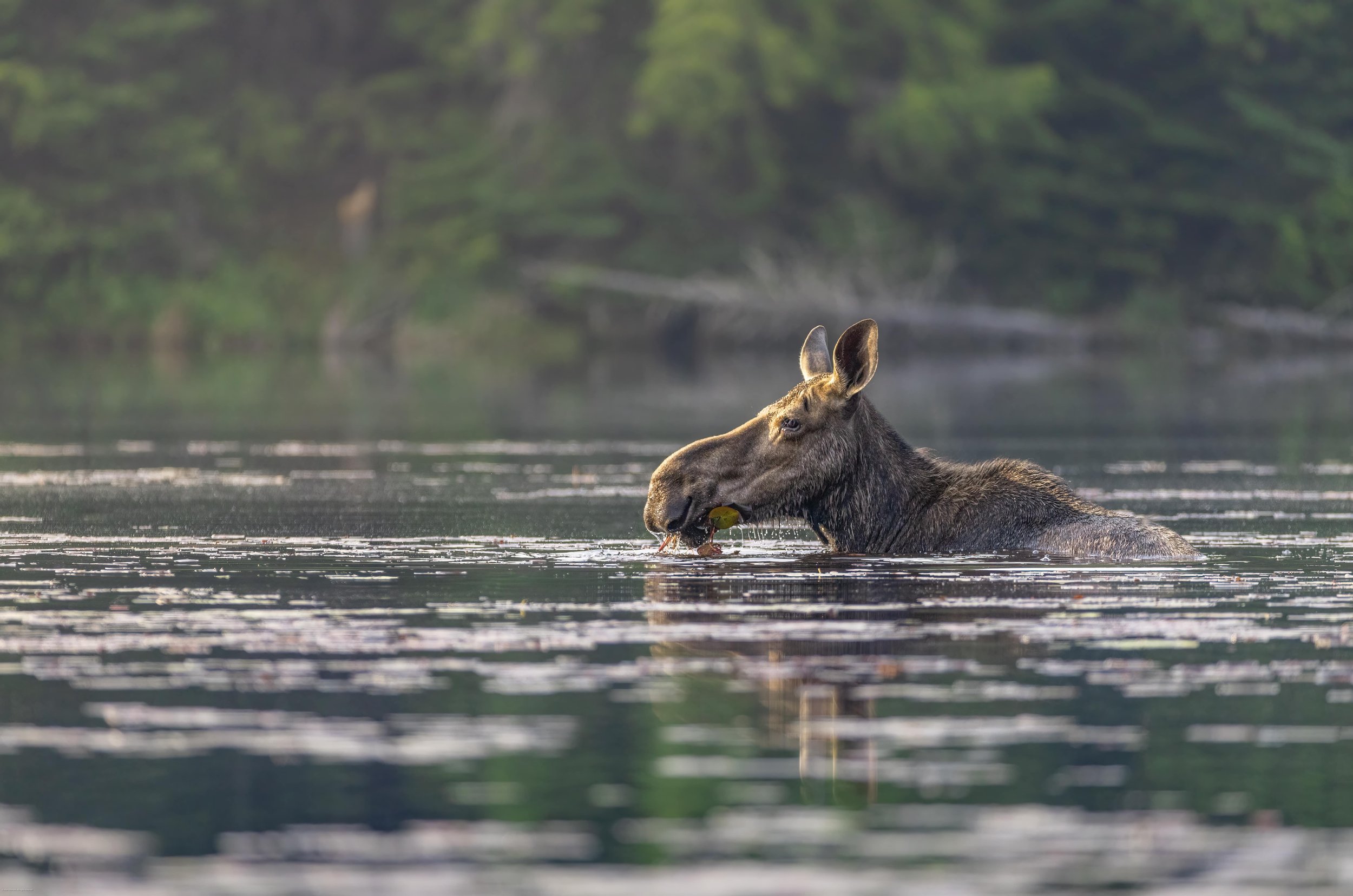
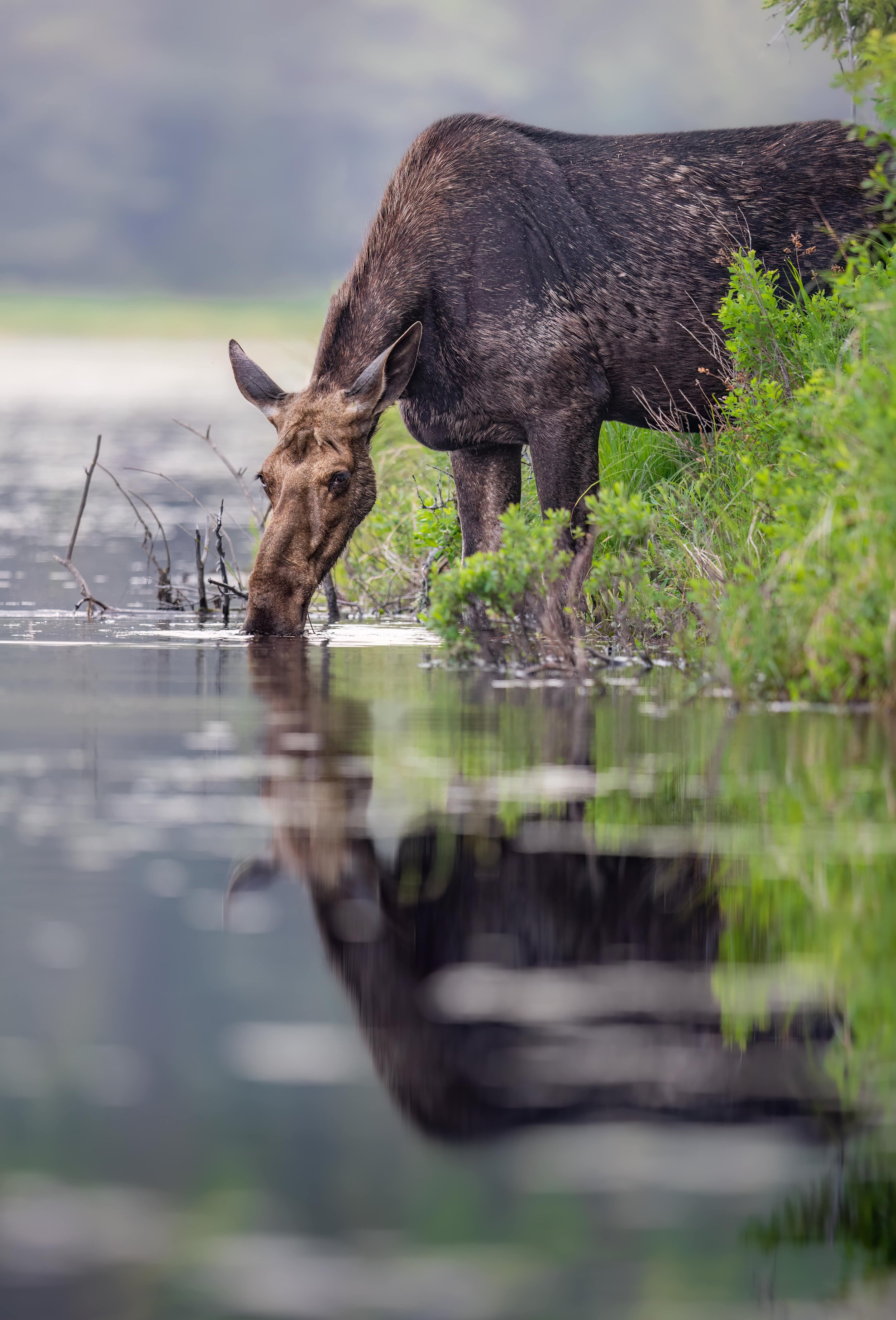
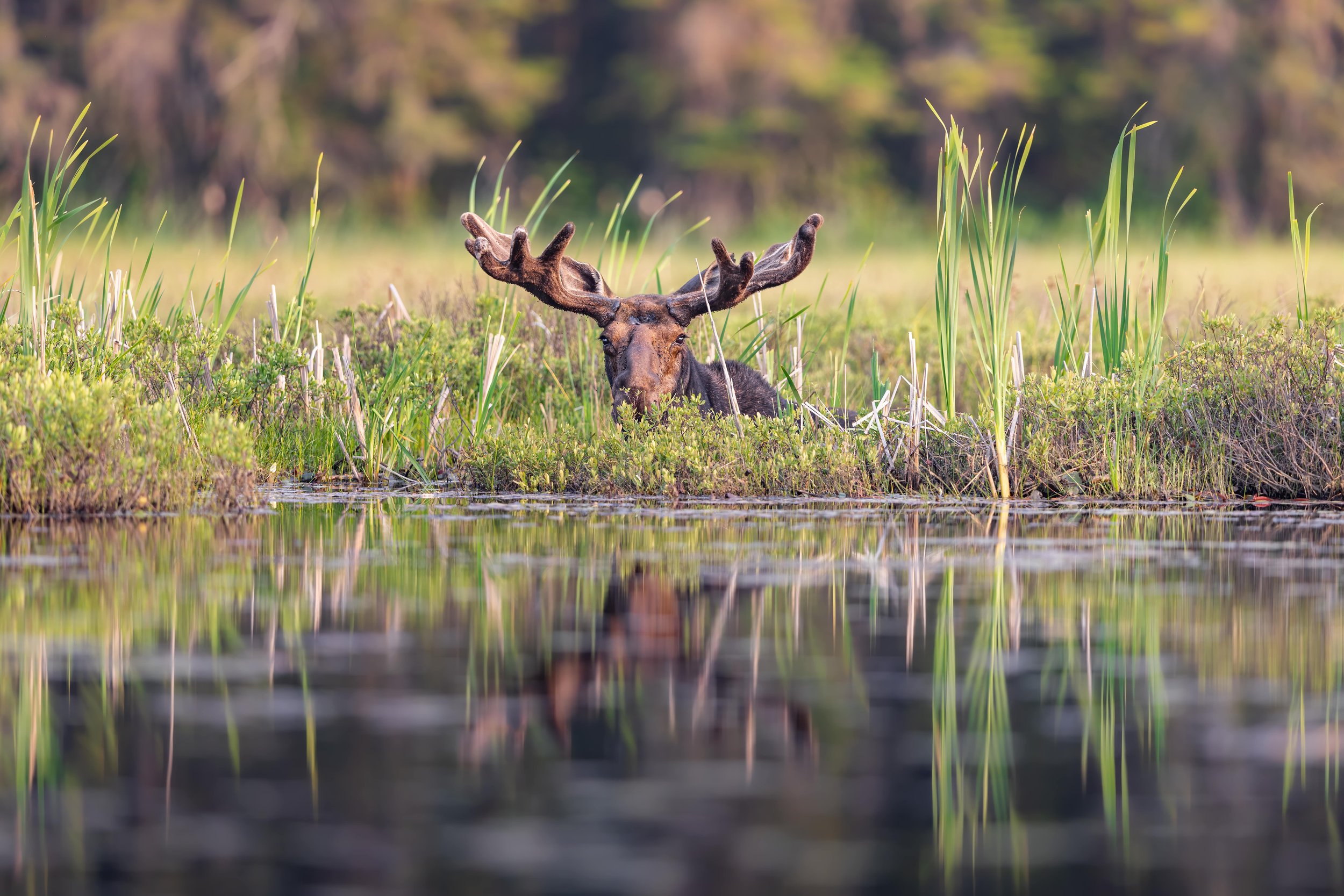
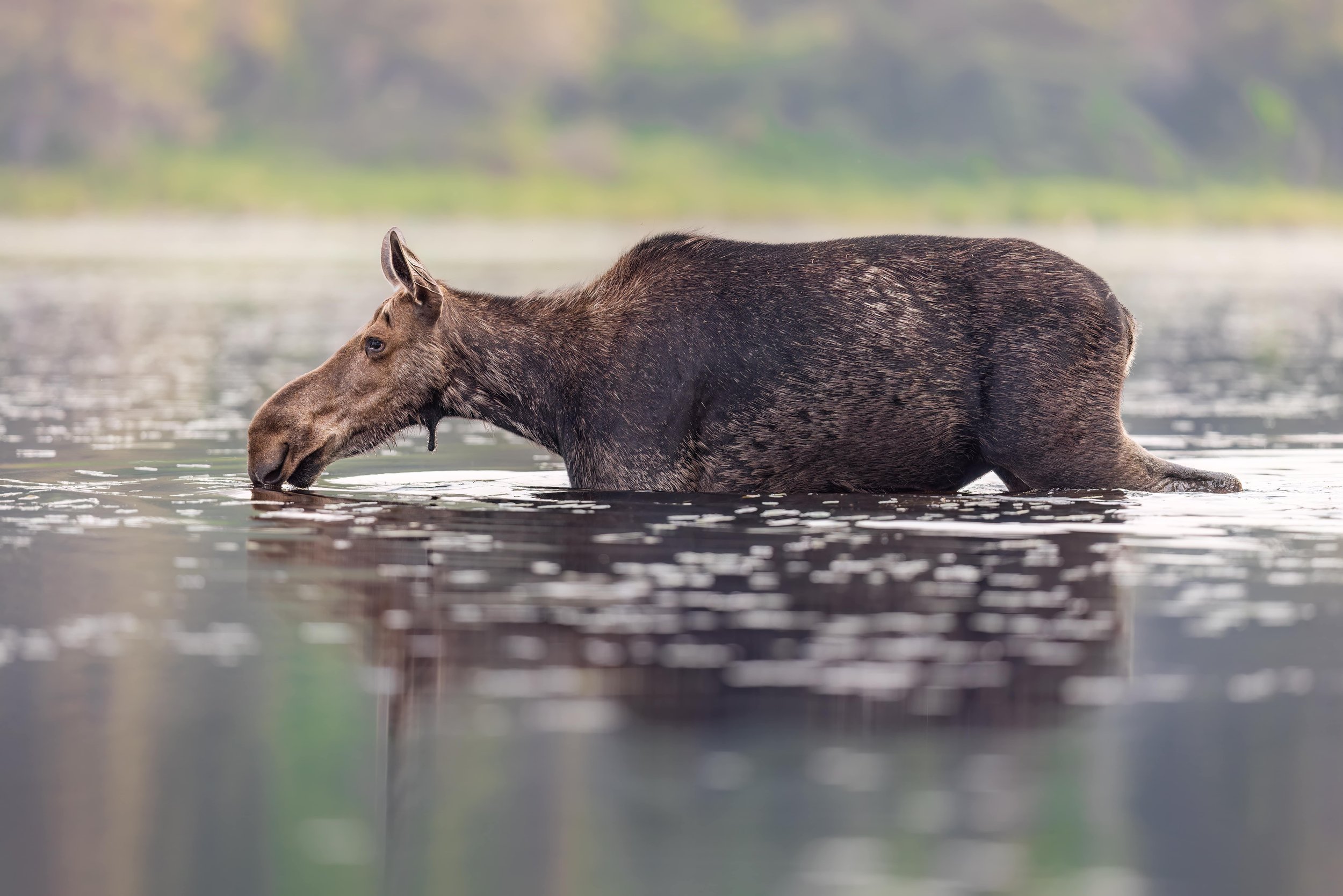
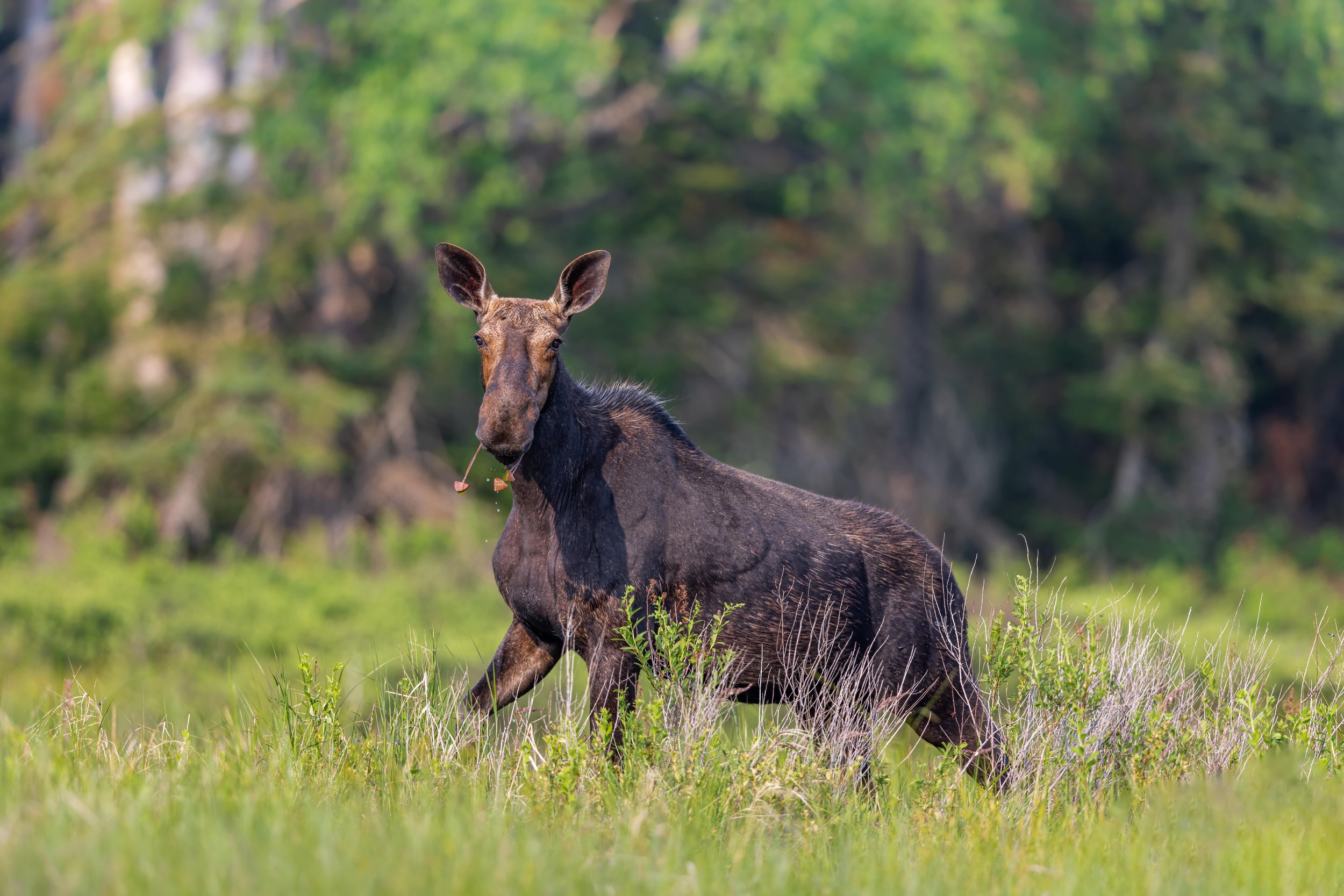
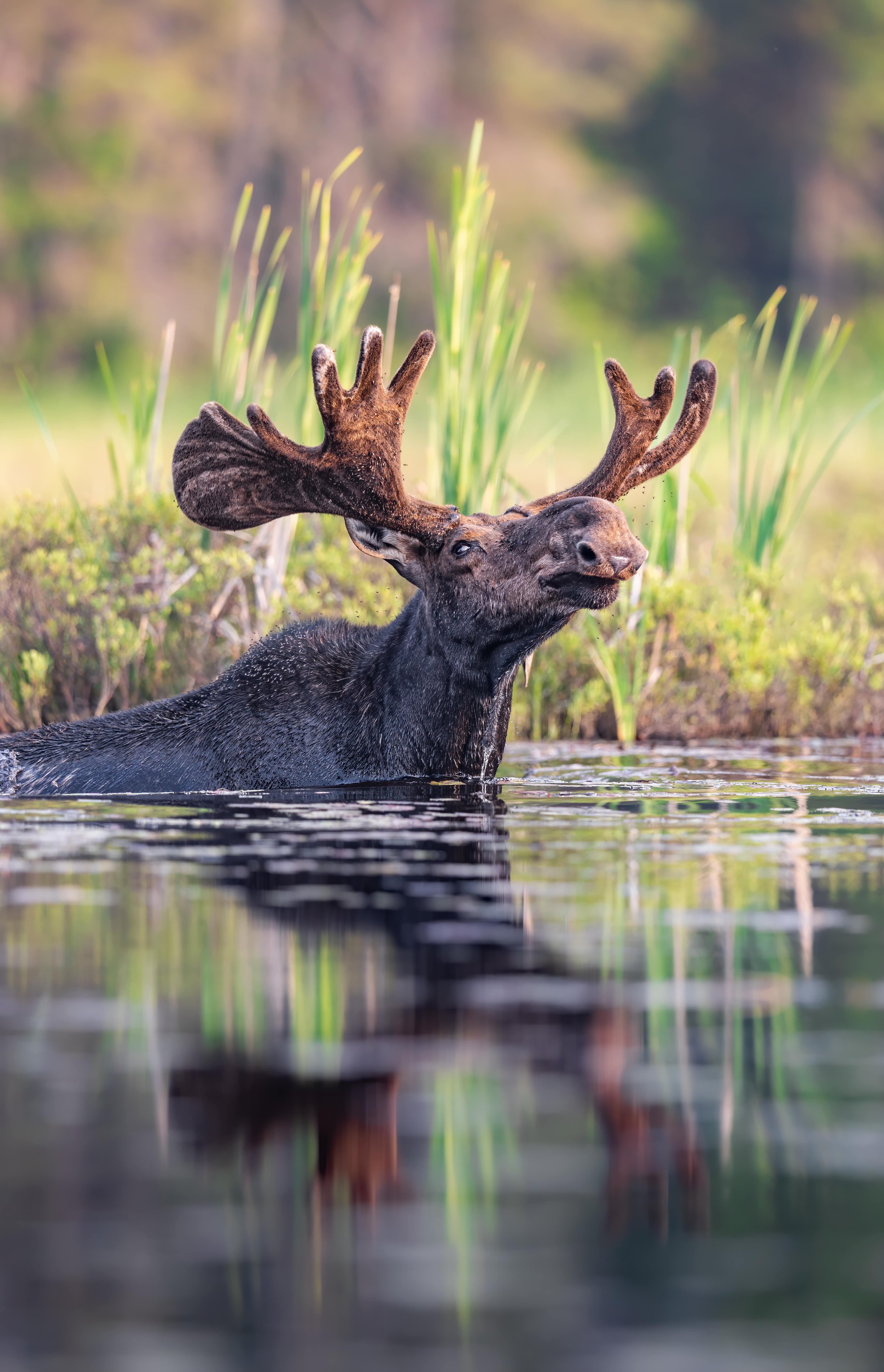
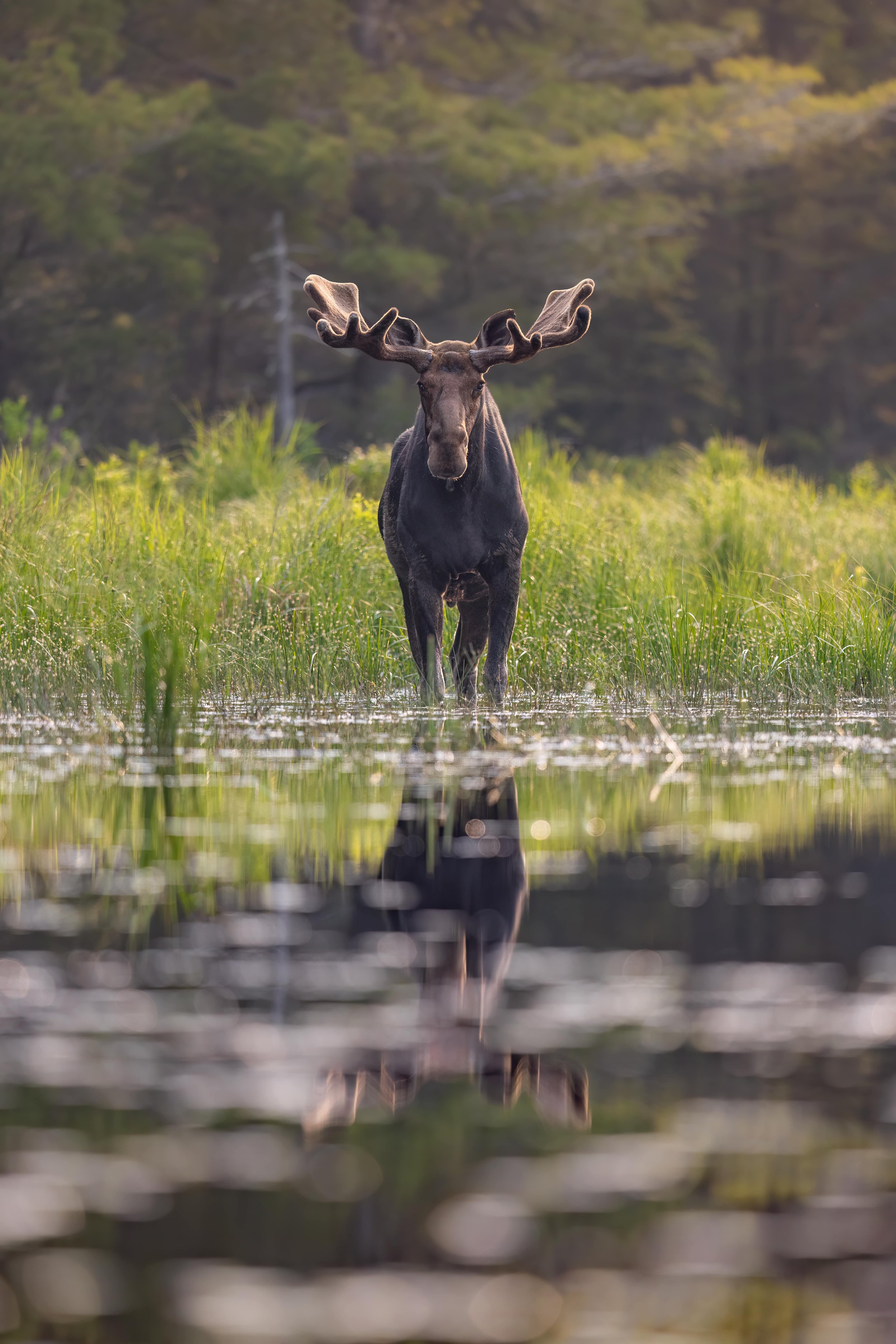
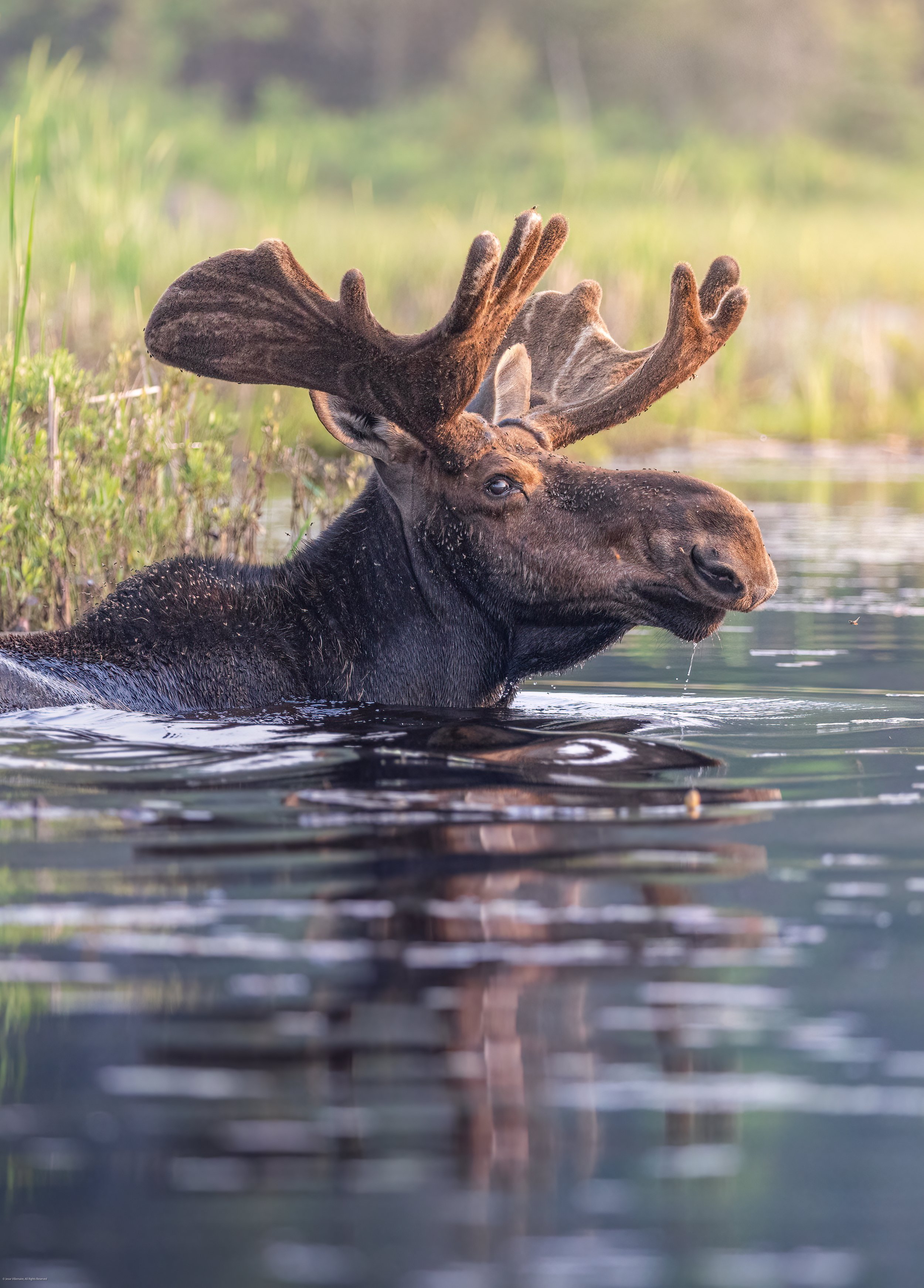
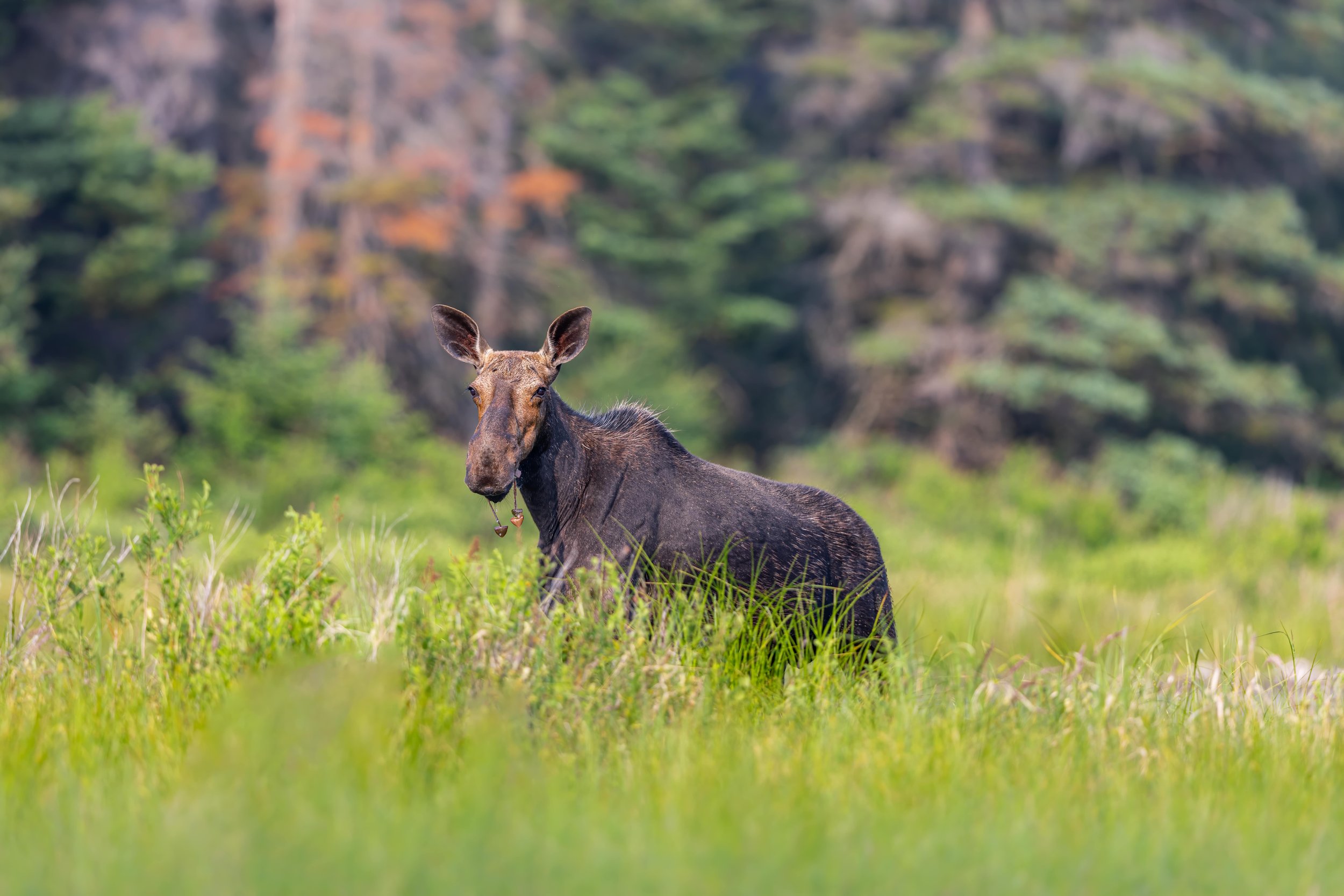
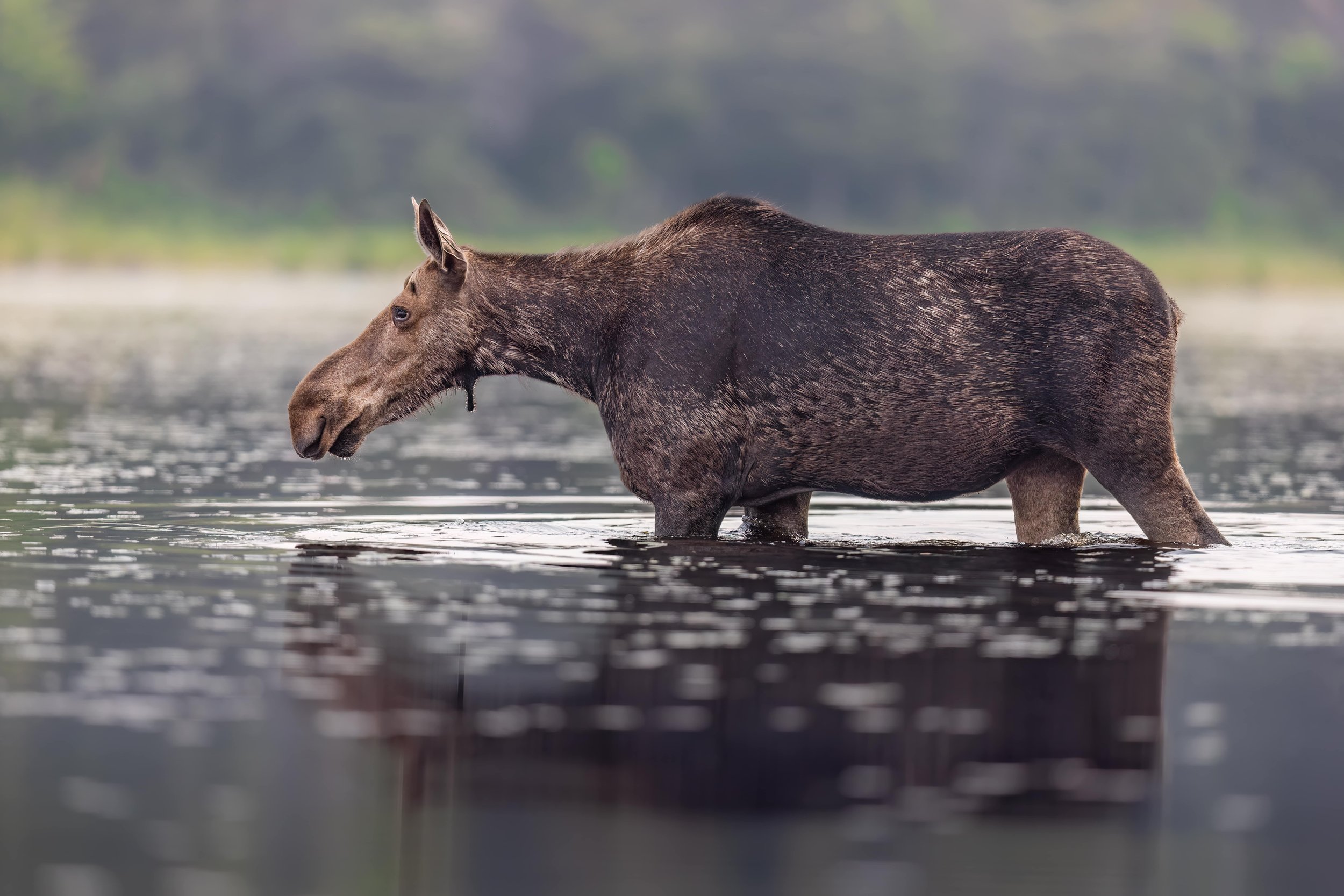
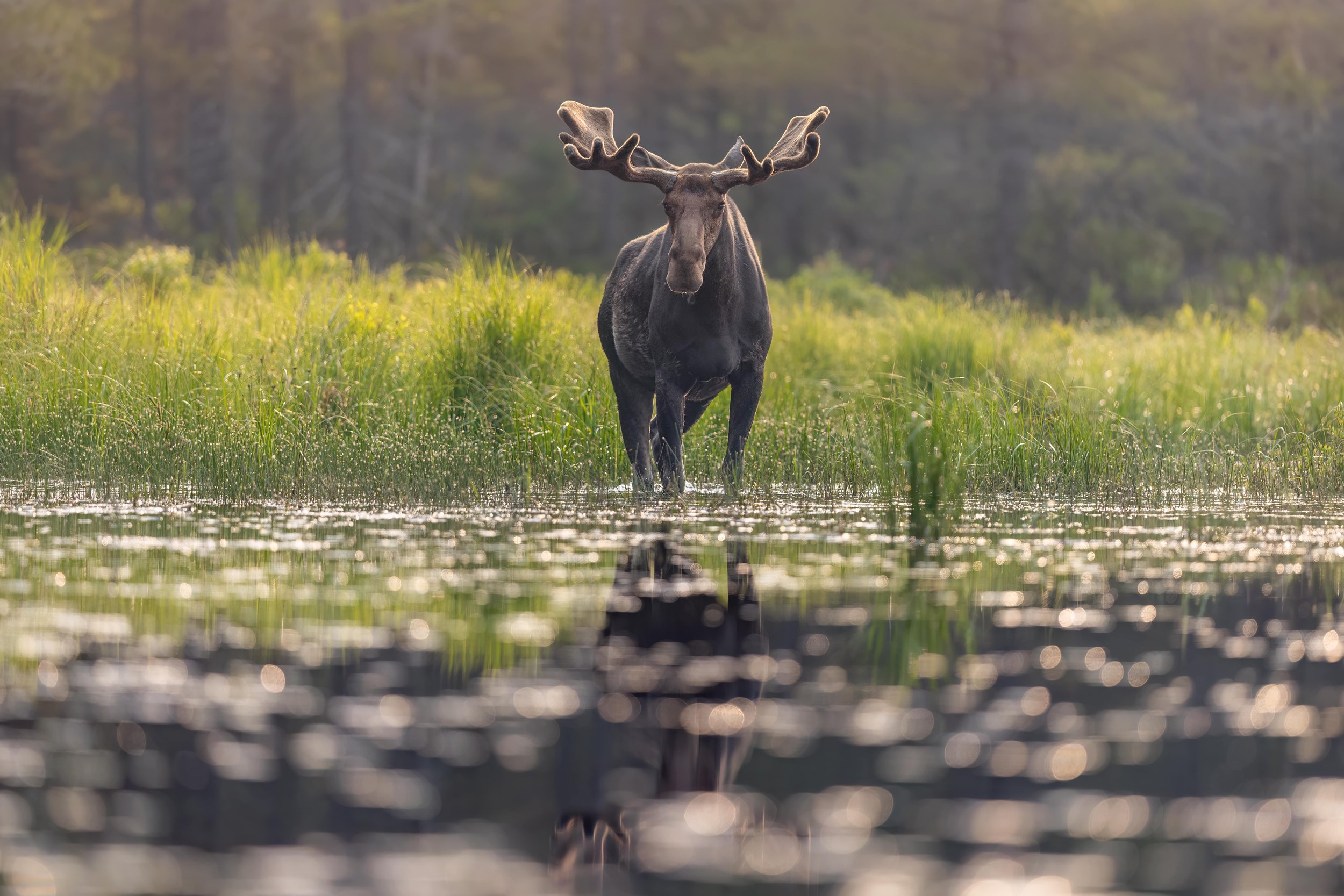
Perhaps our favourite swimmers of the week were two twin moose calves, following mom like train cars as she raced to the shore of our campsite! With all the excitement, it was hard to fall asleep that evening. We waited patiently under a saturated full moon— listening to every twig snap, frog trumpet and mysterious bumps in the night, anticipating them all to be the moose family of three. But, to no avail.
Our Favourite Backcountry Camping Tools and
Creature Comforts
Embarking on a backcountry camping adventure is an exhilarating experience, but it requires careful planning and preparation.
Start with a reliable backpack. It should be durable and comfortable to wear for long periods. Our favourite all-purpose, water-resistent backpack is our f-stop ANJA DuraDiamond Adventure and Travel Backpack. With this pack, we divide the space between camera gear, toiletries and clothing. When we travel internationally, this backpack allows us to fly with carry-on only. The interchangeable/removable internal inserts allow us to get creative with how we utilize space. For added storage and/or storing dirty clothes, we utilize the Bramble Heavy Duty Vacuum Storage Bags. Hot tip: Roll your clothes instead of folding them to save space.
Let there be caffeine. Our favourite compact camping stove is the MicroMo Cooking System from Jetboil. With this, we can enjoy tea and oatmeal in under two minutes. It’s that fast to boil! For traditional wood fires, don’t forget waterproof matches or a fire starter.
Fuel your body for adventure. We need to save all the space we can for camera gear when we’re camping. On this trip, we opted for dehydrated meals and we’re glad we did! Not only were the meals fast to prepare (under 10 minutes), they had relatively no clean-up and were surprisingly tasty! Our favourite brands for dehydrated foods are Happy Yak (their Vegetarian Taco Mix is delicious), Backpacker’s Pantry and Alpine Aire.
Stay hydrated. Water purification tablets or a water filter can be a lifesaver when you're far from clean water. We invested in the MSR Autoflow XL Gravity Filter. Simply fill unfiltered water into the bladder and hang it from a tree at camp. Easy peasy!
Get quality rest. A high-quality tent, sleeping pad and sleeping bag are critical to getting the most out of your backcountry experience. The Big Agnes Blacktail Hotel 2-Person Tent is compact, lightweight, easy to set up and take down, and most importantly….easy to stuff in a backpack or bear barrel for transport. We picked up two LSO 3D Lite FlexForm Self-Inflating Sleep Pads from Costco to test on this trip and we can confidently recommend them (especially for the price). Do yourself a favour and invest in the Deluxe Pillow from MEC, too. The best camping pillows we’ve ever had.
Be bear aware. A bear barrel, also known as a bear canister, is a crucial piece of camping equipment designed to store food and other scented items securely, preventing bears and other wildlife from accessing them while you're camping in the backcountry. We use the Recreational Barrel Works Expedition Barrel Harness. It’s easy to carry because of its padded backpack straps and has stood the test of time.
Keep the bugs away. It's ironic that the prime time for spotting moose is in June, and conveniently coincides with the time of year you donate the most blood to mosquitos and black flies in the park. Trust us when we say, you will be grateful to have the super compact and light Eureka NoBugZone Shelter to be able to enjoy the views outside of your tent during the day. And, when you want to escape your campsite, we recommend the Ontario-made ‘Original Bug Shirt.’ This jacket saves us on every hike and portage from May-July!
PSA: Remember, leave no trace behind. Respect nature by ensuring you take all trash with you. Backcountry camping is about immersing yourself in the wilderness and leaving it untouched for the next travellers to enjoy.
The Healing Power of Nature
Research has shown that spending time in nature can have significant health benefits. It reduces stress and lowers blood pressure. The simple act of being in the great outdoors, away from artificial lights and screens, can help reset our internal clocks.
Backcountry camping serves as a reminder of the beauty of simplicity. It provides a space where we can disconnect from daily stresses and reconnect with ourselves.
If you find yourself feeling heavy, even overwhelmed by the pace of life, consider escaping into the wilderness. You might be surprised by the peace and clarity you find amidst the quiet moments and the stillness.
“…We need so much less than we take.
We owe so much more than we give.
Squirrels plant thousands of trees every year
just from forgetting where they left their acorns.
If we aimed to be just half as good
as one of the earth’s mistakes,
we could turn so much around.
Our living would be seed, the future would have roots.
We would cast nothing from the garden of itself.
and we would make the thorns proud.”
- Andrea Gibson, Homesick: A Plea For Our Planet















